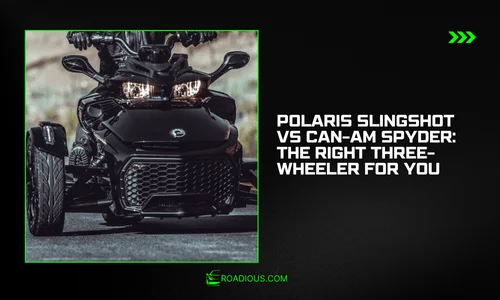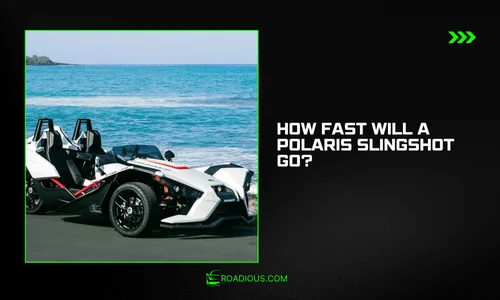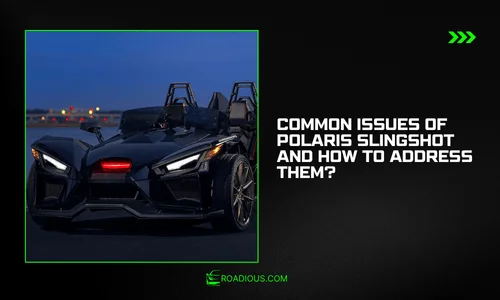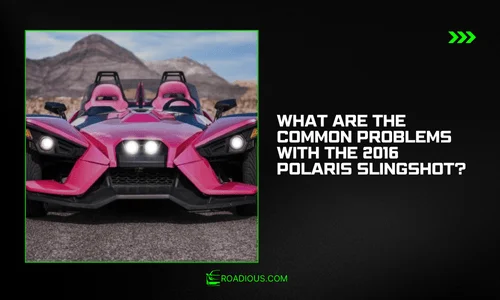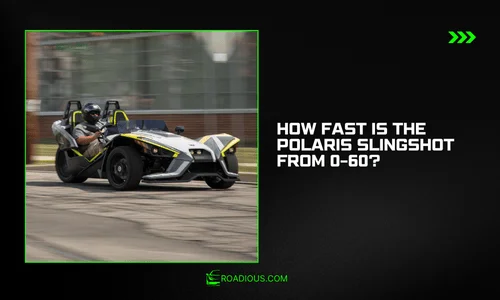I remember the first time I saw a Polaris Slingshot parked at a gas station; it looked like a spaceship. Just a week later, I passed someone cruising down the highway on a Can-Am Spyder, and it made me pause and really think: Which one of these three-wheeled machines offers the better experience? If you’re debating between them, you’re likely weighing fun against function, thrill against touring comfort. Let’s break down everything you need to know before making that call.

Basic Design & Classification
Polaris Slingshot
The Slingshot isn’t quite a car, but it’s not a motorcycle either. It has a steering wheel, foot pedals, bucket seats, and a low-slung open cockpit that makes you feel like you’re piloting a land rocket. Despite the exposure, it drives more like a cyclecar than anything on two wheels.
Can-Am Spyder
The Spyder sticks closer to its motorcycle roots. It features handlebars instead of a wheel, saddle-style seating, and traditional foot controls. It feels more like a motorbike but offers far more stability thanks to its reverse trike setup as compared to the AM Ryker.
Powertrain & Performance
Engine & Transmission
The Slingshot packs serious punch with a 2.0L to 2.4L inline-four engine, generating up to 203 horsepower. It comes in both manual and automatic variants, so you can choose your driving style.
The Can-Am Spyder F3 runs on a 1.33L Rotax triple-cylinder engine with around 115 horsepower. It uses a semi-automatic transmission that balances rider control and comfort.
Handling & Ride Feel
The Slingshot weighs in at about 1,650 pounds and hugs the road like a sports car. Its wide front stance and low center of gravity give it exceptional handling.
The Spyder, lighter at about 1,000 pounds, offers more of a quad-bike feel. Its upright riding posture and motorcycle-based chassis bring a completely different kind of agility; a blend of security and sportiness.
Learn More: Polaris Slingshot vs Can-Am!
Comfort & Features
Seating & Controls
In the Slingshot, you get proper bucket seats, seat belts, and even a rollover bar. But you’re still exposed to the elements, which adds thrill but reduces comfort during long rides.
The Spyder offers a more upright position with plush saddle-style seating. With some models offering automatic shifting and cruise control, it’s clearly built with long-distance touring in mind.
Storage & Touring
Storage is one of Slingshot’s weak points. You might squeeze a few essentials under the seats or behind the passenger footwell, but not much else.
The Spyder RT, however, is a tourer’s dream: front trunk, saddlebags, and even a rear top case. You could pack for a weekend and still have room to spare.
Safety & Rider Experience
Exposure and Protection
Driving a Slingshot is a mix of thrill and vulnerability. You’re seated low, strapped in, but with minimal shielding. It feels like a go-kart with horsepower.
The Spyder gives a more protected feel. Its fenders and foot protection add a layer of safety. While not fully enclosed, you don’t feel as exposed.
Rider Feedback and Controls
The Slingshot’s steering feels tight and responsive, but it lacks that motorcycle-like lean. It’s more driver than rider.
Spyder riders get stability and ABS systems built-in. Some hardcore bikers find its electronics too controlling, but most riders appreciate the balance of safety and engagement.
Pricing & Value
MSRP and Trim Options
The Slingshot starts around $21,000 and climbs depending on trim: S, SL, SLR, or R. It’s an investment in performance and flair.
Can-Am Spyder models vary: Ryker starts near $9,600, the F3 S around $20,900, and the luxury-touring RT near $26,800.
Cost Considerations
Slingshot ownership comes with slightly higher fuel use and maintenance costs. That said, the driving experience is unique and often worth it for enthusiasts.
The Spyder is more fuel-efficient and loaded with touring features. Some riders do mention minor reliability issues, but its comfort and practicality often outweigh the cons.
Rider Profiles & Use Cases
If you’re after head-turning design, sportscar-like handling, and weekend adrenaline, the Slingshot is your machine. It’s perfect for drivers who want something bold and unconventional.
The Spyder, on the other hand, appeals to motorcyclists who want more stability without sacrificing the open-road experience. It’s also ideal for older riders or those looking for a more relaxed touring setup.
Real User Insights
Real-world riders back this up. Many say the Slingshot feels more like a road-hugging car with its tight turns and torque. Others love the Spyder for its comfort, especially on long rides. Some do note its wide frame and highly electronic feel can be a bit much.
“The Slingshot is for people who want to be seen; it’s flashy, fast, and hard to ignore,” says auto journalist Travis Coleman.
“The Spyder lets me enjoy long rides without worrying about balance or fatigue,” shares touring enthusiast Karen Burke.
so, Which One’s Right for You?
So, what’s the final verdict? The Polaris Slingshot wins if you want raw excitement, a car-like feel, and a vehicle that turns heads everywhere it goes. But if comfort, storage, and a true touring experience matter more, the Can-Am Spyder is likely your best match.
Both are excellent choices depending on what you value most. Think about your riding habits, where you’ll take it, and how much comfort vs. adrenaline you’re chasing. Either way, you won’t be disappointed; just be sure it fits your lifestyle before you twist that throttle or grip that wheel.

